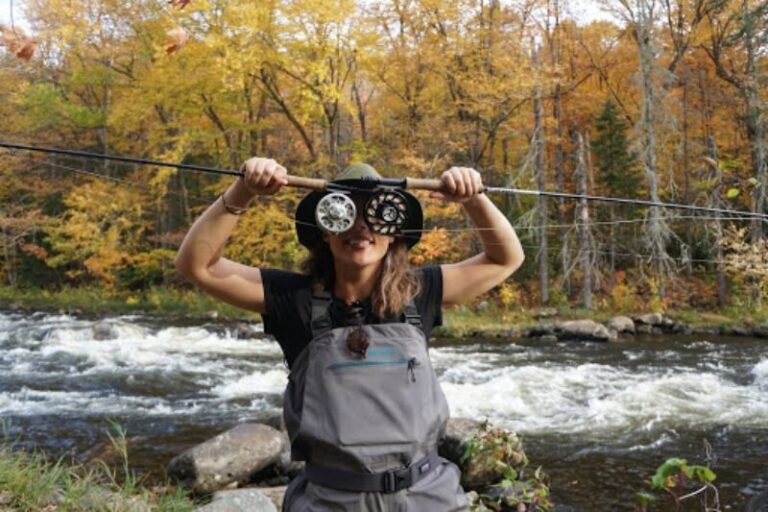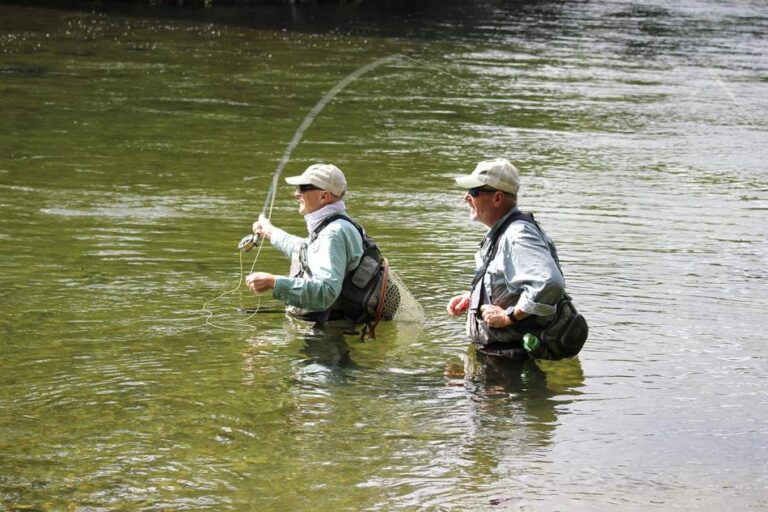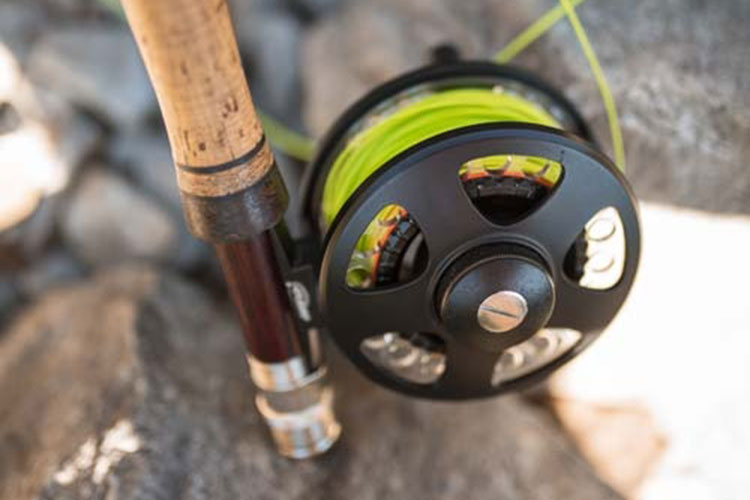Mastering streamer fishing techniques in fly fishing involves understanding the behavior of fish and selecting the right streamer pattern to imitate their prey. To become a successful streamer angler, you must learn to vary the speed and depth of your retrieve, use the right gear, and stay sharp on your casting accuracy.
Welcome to the world of streamer fishing in fly fishing! A streamer is an artificial fly designed to mimic a small baitfish, leech, or other aquatic creatures that fish prey on. Streamer fishing is a popular technique used to target larger fish in streams, rivers, and lakes.
To become a successful streamer angler, you must learn to master various techniques and tactics, such as the retrieve, stripping methods, and fly selection, among others. In this article, we’ll explore some of the essential techniques that you need to learn to get started with streamer fishing. So, let’s dive in!

Credit: www.ebay.com
What Are Streamer Tactics?
Mastering Streamer Fishing Techniques In Fly Fishing
Fly fishing is a thrilling sport that requires patience, expertise, and the right gear. If you’re a seasoned angler or a beginner, learning about streamer tactics is an essential part of mastering streamer fishing techniques in fly fishing. In this blog post, we’ll explore what streamer tactics are and why they’re crucial in fly fishing.
Definition And Explanation Of Streamer Tactics
Streamer tactics are fly fishing techniques that involve imitating small baitfish with streamer flies. These flies are usually larger than traditional dry flies, and they move through the water to attract predatory fish like trout, bass, and pike. Here are some key points to help you understand streamer tactics:
- Streamer tactics require heavier gear than traditional fly fishing, such as a 7-8 weight rod and a sinking line.
- The goal is to mimic the movement of injured or fleeing baitfish to trigger a predatory response from fish.
- Streamer flies often have materials like marabou, rabbit fur, or synthetic fibers to create a lifelike swimming action.
- A successful streamer tactic involves continuous casting and retrieval, varying the speed and depth of the fly, and experimenting with fly colors.
Importance Of Streamer Tactics In Fly Fishing
Streamer tactics are a game-changer in fly fishing because they give anglers the ability to target large fish that aren’t interested in traditional dry flies. Here are some reasons why streamer tactics are important in fly fishing:
- Streamer fishing allows you to fish deeper and cover more water than traditional fly fishing, increasing your chances of hooking big fish.
- Using streamer tactics is a great way to adapt to changing weather or water conditions.
- Streamer flies can be effective year-round, especially during low light conditions or when fish are actively feeding on baitfish.
- Because streamer tactics are more active than traditional fly fishing, they can be more engaging and rewarding for anglers.
Streamer tactics are an essential part of mastering streamer fishing techniques in fly fishing. Understanding how to imitate baitfish with streamer flies and varying your casting and retrieval techniques can greatly increase your chances of hooking large fish. Don’t be afraid to experiment with different streamer patterns and tactics to find out what works best for you.
Happy fishing!
Step 1: Understanding Streamer Flies
Mastering Streamer Fishing Techniques In Fly Fishing
Streamer fishing techniques in fly fishing can be incredibly effective, especially for catching predator fish like bass or pike. To successfully master these techniques, there are several steps to consider.
Streamer flies are a type of fly used for fly fishing that imitates baitfish, sculpins, or leeches. They are usually larger and heavier than other types of flies and can be fished in various ways, including stripping, swinging, and dead drifting.
Here are some key points to understand about streamer flies:
Types Of Streamer Flies
- Woolly buggers: One of the most popular streamer flies that can be fished in various ways. These flies are versatile and can mimic a wide range of baitfish.
- Clouser minnows: Designed to mimic small baitfish, clouser minnows are great for targeting predator fish. These flies can be tied in various sizes, colors and are made using different materials.
- Sculpin patterns: These streamers mimic the sculpin fish and have a bulky design with a prominent head and a tapered tail.
The Anatomy Of Streamer Flies
Streamer flies have a few key parts that imitate baitfish. These parts include:
- Head: The head is the front part of the fly that usually has painted or threaded eyes to mimic the eyes of baitfish.
- Body: The body of the streamer fly is often bulky and can contain different types of materials to mimic the shape of baitfish.
- Tail: The tail of the streamer fly is usually made up of feathers, fur or synthetic fibers that mimic the tail of baitfish.
- Hook: Unlike other types of flies, streamer flies usually have heavier hooks to support their larger size and weight.
Understanding the different types of streamer flies and their anatomy is crucial to effectively using them in fly fishing. In the next step, we’ll discuss how to select the right streamer fly for your fishing situation.
Step 2: Choosing The Right Equipment
Mastering Streamer Fishing Techniques In Fly Fishing
Fly fishing is an artform that requires patience, skill, and precise techniques. Streamer fishing, in particular, requires anglers to choose the right equipment and execute proper techniques to catch the fish they desire. We will explore the second step to mastering streamer fishing techniques: choosing the right equipment.
Fly Rods For Streamer Fishing
When it comes to fly rods for streamer fishing, you need to know that bigger is not always better. A good rule of thumb is that your rod should be at least an 8 weight. This is because streamer fishing usually requires larger and heavier flies, which require more power to cast.
Some of the things you need to consider when choosing fly rods for streamer fishing are:
- Power: Your rod should have enough power to cast bigger flies and fight bigger fish.
- Length: Longer rods provide more leverage to fight fish, but they can be more challenging to cast in windy conditions. Shorter rods are easier to cast, but may not provide as much leverage when fighting fish. A 9 to 9.5-foot rod is a good starting point.
- Action: A fast action rod will help you cast farther and more accurately, but a medium action rod will give you more control.
- Material: Graphite rods are popular because they are lightweight and more powerful than fiberglass or bamboo.
Reels And Lines For Streamer Fishing
A good reel is essential in streamer fishing because it will hold the line and provide a smooth drag. When it comes to reels for streamer fishing, you need to look for the following features:
- Capacity: Your reel should have enough capacity to hold the line you need for your rod.
- Drag system: A good drag system is crucial in streamer fishing because it will help you fight the fish. You should look for a reel with a strong, smooth, and adjustable drag system.
- Weight: Your reel should be balanced with your rod to provide a comfortable and efficient fishing experience.
- Material: The material of the reel should be strong and durable to withstand the pressure of fighting fish.
When it comes to lines for streamer fishing, you need to choose a line that matches your rod and reel. A weight-forward floating line is a good starting point, but you may also want to consider a sink-tip line. Here are some things to consider when choosing lines for streamer fishing:
- Weight: Your line should match the weight of your rod.
- Density: Floating lines are ideal for surface fishing, while sink-tip lines are better for fishing deep waters.
- Taper: A weight-forward taper is better for casting larger flies, while a double-taper taper provides more delicate presentations.
Choosing the right equipment is crucial in streamer fishing. Your equipment should match the type of fishing you are doing and the fish you are targeting. A good rod, reel, and line will make your streamer fishing experience more enjoyable and successful.
Step 3: Perfecting Your Technique
Mastering Streamer Fishing Techniques In Fly Fishing
If you want to catch big trout, streamer fishing is the way to go! Streamer fishing is a technique used by fly fishermen to target predatory fish such as trout and bass. It involves casting a fly that imitates a fish or a minnow and then retrieving it in a way that attracts the attention of the fish.
Streamer fishing is all about using the right techniques to make your fly look like a real fish and attract those hungry trout. In this post, we’ll look at some casting and retrieval techniques to help you perfect your streamer fishing.
Casting Techniques For Streamer Fishing
Casting a streamer fly is a little different from casting dry flies or nymphs. Here are some tips to help you cast streamers with ease:
- Use a heavy fly line: Streamer flies can be pretty heavy, so it’s important to use a heavy fly line to be able to cast them with ease. Heavier fly lines will help you cast further and more accurately.
- Use a single-haul cast: Streamer fishing is all about power and accuracy, and the single haul cast allows for both. This type of cast uses a simple back-and-forth motion to generate more power and line speed, which is ideal for casting heavier flies.
- Use a horizontal forward stroke: With streamer fishing, you want to cast your fly close to the bank or structure where fish are hiding. A horizontal forward stroke helps you do this by allowing you to keep the fly low to the water and avoid getting snagged in trees or bushes.
Retrieval Techniques For Streamer Fishing
Now that you’ve cast your streamer fly, it’s time to start retrieving it. The key to retrieving a streamer is to make it look like a real fish, and there are several ways to do that. Here are some retrieval techniques to try:
- Strip retrieve: This technique involves retrieving the fly in short, quick strips, imitating a fleeing baitfish. Vary the length and speed of your strips to mimic a swimming fish and entice the trout to strike.
- Dead drift: Essentially the opposite of the strip retrieve, a dead drift means allowing the fly to drift naturally with the current, imitating a dead or injured fish. This technique can be very effective when fishing in slow-moving water or along the bottom of a river.
- Swing retrieve: This technique involves casting your fly across the current and letting it swing downstream, imitating a baitfish moving with the current. This technique is great for fishing deep pools or fast-moving water where trout may be hiding.
With these tips and techniques, you’re well on your way to mastering streamer fishing in fly fishing. Remember, practice makes perfect, so keep trying different techniques and find what works best for you. Soon enough, you’ll be catching big trout like a pro!
Step 4: Locating The Fish
Identifying Prime Spots For Streamer Fishing
When it comes to streamer fishing, one of the most important aspects of having a successful fishing trip is locating the fish. Knowing where the fish are most likely to be found will help you to cast more accurately and increase your chances of catching a fish.
Here are some tips for identifying the prime spots for streamer fishing.
- Look for current breaks: Trout and other game fish will typically be found behind boulders or other objects in the water that break the current. Cast your streamer in these areas for a higher chance of catching a fish.
- Check out deep holes: As the water warms up, fish will often seek out deeper water to cool off. Look for deeper pockets of water, such as deep runs or pools, to find fish.
- Focus on transition zones: Transition zones are areas where two different types of water meet, such as faster current meeting slower current. Fish will often be found in these areas as they provide an opportunity for them to ambush prey.
- Consider the time of day: Depending on the time of day, fish will be found in different areas of the river. In the morning and late afternoon, fish will tend to be in slower moving water. During the middle of the day, when it is hotter, they will typically be found in deeper water.
Tips For Reading The Water
Reading the water is an important skill to have when streamer fishing. By being able to read the water, you will be able to identify where the fish are likely to be and make more accurate casts. Here are some tips for reading the water.
- Look for riffles and runs: Riffles and runs are areas of the river where the water is moving faster. These areas are great for streamer fishing as they provide a lot of oxygen and food for the fish.
- Watch for rising fish: If you see fish rising to the surface, it’s a good indication that there is some sort of hatch occurring. This means that fish will be feeding on the surface, making it a great time to try dry fly fishing.
- Keep an eye out for structure: Fish will often be found around structure in the water, such as logs or rocks. Cast your streamer near these objects for a higher chance of catching a fish.
- Check the water temperature: As mentioned earlier, fish will seek out cooler water during the hotter parts of the day. Use a thermometer to check the water temperature, and focus your efforts on deeper water if the temperature is high.
By following these tips for reading the water, you will be able to locate the prime spots for streamer fishing and increase your chances of catching fish. Keep in mind that reading the water takes practice, so don’t get discouraged if you don’t catch fish right away.
Remember, consistent practice and using a variety of techniques will help you become a master of streamer fishing. Happy fishing!
Step 5: Other Considerations
Mastering Streamer Fishing Techniques In Fly Fishing
If you are looking to incorporate streamer fishing into your fly fishing game, there are several crucial factors to consider. We have covered the first four steps, ranging from selecting the right equipment, choosing the right streamer, and casting and retrieving techniques to entice the fish.
In step five, we will shed some light on other essential considerations for perfecting your streamer fishing skills.
Streamer Tactics And Weather Conditions
Streamers are versatile flies that mimic baitfish, leeches, and other aquatic creatures to lure predators such as trout, bass, and pike. One way to increase the chances of landing these predators is by adjusting your streamer tactics according to the weather conditions.
Here are some pointers to improve your streamer fishing tactics:
- In low light conditions, use a bigger and brighter streamer, or slow down the retrieve technique
- In clear water, opt for smaller streamers, use natural colors, and use a steady retrieve technique
- In dirty or murky water, use bigger and darker streamers with flashy materials and a slower retrieve technique
Best Time Of Year For Streamer Fishing
While streamers are effective throughout the year, certain times of the year can yield better results. The peak season for streamer fishing is fall, followed by spring.
Fall:
- Water is cooler, and fish are aggressive as they prepare for winter
- Big brown and rainbow trout spawn in the fall, making them more aggressive and territorial
- Increasing amounts of baitfish moving towards shallow water draws predatory fish closer to the surface, making them more visible and easier to target.
Spring:
- Similar to fall, fish are starting to become more active after winter
- Fish are now looking for high protein/ high-fat foods, which is where baitfish imitating streamers come in handy
- High water levels from runoff quicken the river, making streamer fishing more active as fish become more vulnerable.
With these streamer techniques and factors in mind, you can master the art of streamer fishing and catch the biggest fish of your life. Keep practicing and testing new tactics until you find the perfect combination that works for the weather conditions, time of year, and body of water.
Good luck out there, and happy fishing!
Conclusion
Streamers are effective in catching fish, especially in deep waters where large predators lurk. As a fly fisherman, mastering streamer fishing techniques is essential in your pursuit of that trophy catch. By choosing the right streamer pattern, understanding the currents and depths of the water, and properly presenting your fly, you increase your chances of catching a fish that makes your heart race with excitement.
Practice casting, stripping, and retrieving the streamer to achieve a natural and enticing action. This takes time, patience, and dedication to master, but the rewards are worth it. The adrenaline rush that comes with hooking a big fish using streamer fishing techniques is unmatched.
Remember to respect the waters and practice catch-and-release to preserve our precious resources. With these tips and techniques, you can become a master of streamer fishing and enjoy this exciting aspect of fly fishing for years to come. Happy fishing!




